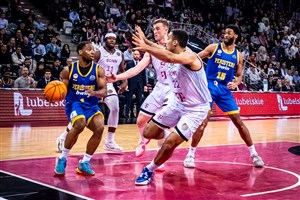
NBL gets basketballsy
MELBOURNE (Paulo Kennedy's View from Downunder) - I promised to look at the curious question of Vinnie or Bubbles this week, but then the NBL went all "ballsy" on us.
Determined to launch a new era under the ownership of Larry Kestelman, the NBL announced this week the 2015/16 season would feature games each and every Wednesday and Thursday in a bid to attract television networks.
It will bring the NBL into direct competition with the most recent juggernaut of Australian sport, cricket's Twenty20 Big Bash League.
“Australia hasn’t seen two major league sports compete for mid-week numbers for some time," - GM Jeremy Loeliger http://t.co/Prd123c1Zl
— NBL (@NBL) July 23, 2015
"Ballsy" was the description used by hoops journo Boti Nagy, and he was right, because with no TV deal locked in, this approach could fall in a heap as much as it could succeed.
But you've got to be in it to win it, and had the NBL gone with the traditional fixture of almost exclusively Friday to Sunday games they wouldn't have been in the television contest at all, with all prime spots (and most others) already locked away by other leagues.
To quote Nagy fully, he called it a ballsy move forward. On that one I'd say yes and no. In some ways it's a move back in time.
The idea of playing weekdays is not new. Nor is the idea of designing a fixture conducive to broadcasters.
The NBL did it the past few years to accommodate the unaccommodating Network Ten. The New Zealand Breakers have been doing it for eons, while the NBL's Big Wednesday achieved infamy for a number of years on Fox Sports.
The idea of shortening the fixture is not new either. The NBL did it in the late 2000s to fit broadcasters, and repeated the dose last year too.
While it's good for TV, it's even better for fans, because it leaves a bigger window for the NBL's best players to cash in post-season in Europe, the Americas or even New Zealand, increasing the chance of them remaining Downunder.
But I digress.
I guess a fair question is, if none of these things are new, why are they ballsy?
It's because none of them have really worked in the past. Perhaps the most predictable reaction on social media was "it didn't work last time so why do it again?"
But the truth is very little the NBL - under countless administrations - has tried in the past 20 years has worked.
Many of them haven't been bad ideas, but when you're not marketing the product, not connecting with grassroots, not producing a quality TV product, and in general just not spending the money needed to make money, good ideas tend to die slow deaths.
Most recently, former CEO Fraser Neill provided the vision of a shorter schedule and more midweek games to attract TV networks.
Roy Ward, who is emerging as Australia's leading basketball newsman, won the internet for the day with his tweet.
Somewhere Fraser Neill is saying "this all sounds very familiar" #NBL16
— Roy Ward (@rpjward) July 23, 2015
Neill's vision was killed by politics and fear of what didn't work in the past. So is the fear of empty stadiums at midweek games founded?
Looking at last season, New Zealand averaged 3,500 midweek at the 4,000-seat North Shore Events Centre and 4,900 at the bigger Vector Arena.
Adelaide attracted 4,176 to their lone Thursday night game, Sydney averaged 4,000 on school nights, Melbourne averaged 3,400, while Perth attracted a whopping 13,316 to their only midweek date.
Given most of these games were played outside the summer school holiday period, and last season the NBL spent next to nothing on promotion, those numbers are quite solid with the exception of Melbourne, whose issues were self-inflicted rather than linked to the fixture.
The AFL, NRL, A-League and BBL have all managed to achieve respectable crowd numbers in selected midweek spots. So there's no reason the NBL can't, if it promotes it right.
Adelaide had great success with occasional cheap ticket promo deals last season, and these are ideal for midweek games outside the holiday period.
During the summer holidays it is a potential bonanza. People everywhere are looking for things to do, so it's a matter of letting them know it's on, and that's where Kestelman's injection of money - and hence staff and capabilities - can come to the fore.
But how well this strategy works out is as much dependent on the big picture as the smaller details.
Provide fans with an online offering worth sharing, the media with highlights worth airing, then more people will start caring because following the NBL is easy.
Secure a broadcast deal - revenue generating or not - that cross-promotes the league, and the job of promoting the league becomes a lot easier.
To cut a long story short, there is huge potential in the approach the NBL is taking. Will it all come to fruition? Only time will tell, but at least the NBL is in the ballpark ready to take a swing.
Kestelman's investment gives the league the luxury of taking this risk, something it hasn't had for a long time, and it would have been a great disappointment if they hadn't been ballsy enough to have a crack at something different.
And how does this help Australian basketball? Well, even with a barely functional NBL, our junior ranks have been going gangbusters, producing countless quality individuals and teams.
Imagine what is possible for hoops in this part of the world if the professional competition starts truly capturing the imagination.
Paulo Kennedy
FIBA
FIBA's columnists write on a wide range of topics relating to basketball that are of interest to them. The opinions they express are their own and in no way reflect those of FIBA.
FIBA takes no responsibility and gives no guarantees, warranties or representations, implied or otherwise, for the content or accuracy of the content and opinion expressed in the above article.

















